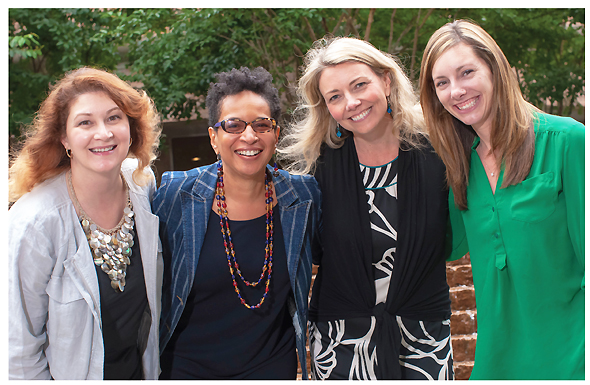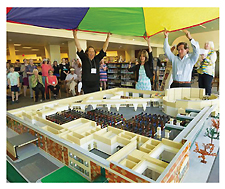Maximizing the Message | LJ 2016 Marketer of the Year Award
Few libraries were untouched by the economic downturn of the 2000s. As systems began to rebound, however, a challenge was to replace the perception that they were down and out with the new reality of extended hours, replenished staff, and improved services. The strongest marketers among them also focused on the stories behind those comebacks, and information about what users could expect going forward. The Charlotte Mecklenburg Library (CML), in the city of Charlotte and County of Mecklenburg, NC, was determined not just to recover but to come back stronger than ever, to make sure its customers knew it—and to give them a chance to tell their side of the story.

THE COMEBACK KIDS The CML Marketing Team (l.–r.): Sarah Goldstein, Angela Haigler, Cordelia Anderson,
and Katy Rust. Photo by Robert Christopher Photography
With director of marketing and communications Cordelia Anderson at the helm, CML has taken a multichannel approach to getting the word out, from a simple but powerful targeted email campaign to a creative video series to hosting a national library marketing conference. These efforts combined have earned the CML marketing and communications team—made up of Anderson, Katy Rust, Angela Haigler, and Sarah Goldstein—LJ’s first annual Marketer of the Year award, sponsored by Library Ideas. The honor recognizes the importance of innovative strategies to marketing library services, the role of marketing in building engagement, and the value of quality marketing efforts and carries a $2,000 cash prize.
STRATEGIES IN PLACE
As the Mecklenburg County tax base shrank during the recession years, CML lost more than a quarter of its budget, from about $41 million to roughly $25 million. As a result, it had to close four branches, lay off about 300 staffers, and reduce hours and services. But beginning in 2012, the library adopted a proactive technique to building itself back up and, with additional funding from the county, was able to restore much of what was lost. Lenoir C. “Lee” Keesler Jr. came on board as CEO that year as well and encouraged leadership to begin thinking in terms of growth again—and to ensure, in the process, that they were telling a positive story.
Keesler added a line item to the library’s budget labeled “strategic marketing initiative.” He told the marketing team, Anderson recalls, “I want you to think carefully about what you want to use it for, and I want you to use it for something that’s very strategic and that is moving the organization forward.”
The new budget allocation coincided with two other important developments: CML’s new strategic planning process and Anderson’s decision to work with analytics provider OrangeBoy to get an accurate picture of who was using what library services, where, and how often. In addition, with the help of a graphic designer and Jennifer Appleby, president of local marketing firm Wray Ward, the library rebranded itself with a new logo.
In 2015, the library received another bonanza in the form of $184,000 from Mecklenburg County to market digital services. CML was ready for its first major marketing push.

COLLATERAL They pushed the idea of the library through (below, clockwise from l.) ads in local movie theaters;
a Facebook Lifelong Learning page piece; an insert in local utility bills; and an outdoor billboard.
All photos courtesy of CML
BRINGING THEM BACK
At the time, CML had a database of more than a million customers, but some 72 percent of them hadn’t used the library in a year or more. Even active patrons included a large proportion of “occasionals,” who hadn’t used library services in at least three months. Many of those occasionals, analytics showed, had children—an “alarm bell for us,” Anderson notes, as the library had identified young users as a demographic it specifically wanted to grow.
Anderson realized that in CML’s case, the old sales axiom applied: it costs less to retain existing customers than to get new ones. Since the marketing department already had a welcome email formatted, it was a simple step to develop a series of messages aimed at lapsed customers, letting them know that they were missed, and occasionals, with a new message every three months highlighting an interesting new service to tempt them back. Using market segmentation data, CML was able to narrow down individuals by the branches and services they last used, allowing the marketing team to develop focused messages. “Having that targeted kind of marketing helps us break through the noise of all the clutter that happens in communication,” explains Anderson. “People begin to see themselves in the messages, and they respond to them.”
Marketing and communications specialist Rust crafted the messages, pairing them with appealing images of library users. The team was able to refine its blasts by working with OrangeBoy to see which got the strongest responses. After its first year, the campaign resulted in 51,700 lapsed library users becoming active again; as of press time, approximately 65,000 patrons have reengaged.
“A LIBRARY OF POSSIBILITIES”
Inspired by a video campaign celebrating the New York Public Library (NYPL) [ow.ly/mLNV304fOgt], CML’s marketing department decided to produce a video of its own. Its video campaign would focus on letting customers tell the public about the library’s successes: its brand, people, and impact.
Working with the local video production firm WonderWorld Creative (which gave the library a $10,000 discount on its services), the CML team filmed a series of conversations with customers about how the library had changed their lives. The resulting eight-minute film was shown in local ballparks and movie theaters and on television. Raw footage was also edited into smaller “snippets” for YouTube (ow.ly/JoXO304fJGA) and other social media around some of the featured patrons. Katherine, who brings her kids to CML’s ImaginOn children’s facility, is one example. “There is something within these walls for everyone,” she says. “It feels like shopping for free. It’s kind of amazing to me that our library offers all of that.” Customer testimonials and photos were also featured in a print brochure.
“That’s what we loved about the video,” says Anderson. “It’s not us talking about the library being great. It’s the customers. It’s the people who actually use the library. There’s so much more credibility to that and so much more genuine insight.”
“Having users tell the story…and why the library’s important to them in a very personal kind of way is very powerful,” says CML director of libraries David Singleton. “It has definitely resonated with our community.”
The American Library Association (ALA) agreed, awarding CML’s “A Library of Possibilities” video campaign its 2016 John Cotton Dana Library Public Relations Award.
“Telling the story is as important as creating it in the first place,” says Keesler. “For people to notice it and be impressed by it, and to give us credit for it, we have to be really good at telling folks what we did.”
The stories, notes Anderson, continue to provide value more than a year later—to customers, community members, and even staff. “When you work for libraries as long as I have, you sometimes lose touch with how meaningful [the library] is to people,” she says. “It’s so nice to be reminded that there are these people who don’t need any convincing.”
SHARING THE GOODS
CML’s successful campaigns put not just the library but specifically its marketing and communications department on the map in a big way. When local media outlets picked up the story, which went viral, Anderson found herself fielding calls asking her for advice. “I was talking to people and sharing this information one at a time,” she recalls, “and part of me was like, hmm, it would be helpful if we could do this all at once.”
While big library conferences often have individual sessions set aside to talk about marketing, Anderson notes, there are few opportunities for library marketing and communications people to sit down together, share best practices, and talk about the issues they face.
With the support of library administration and her team, Anderson decided to explore the idea of holding a library marketing conference at CML. She sent out a survey to her contact list to find out who was interested, what times and dates worked, and what topics people wanted to discuss; the response was overwhelmingly positive. Three months later, the event was a reality.
More than 40 library marketing professionals nationwide attended the meeting, held at CML’s Main Library, May 19–20. Group topics included customer engagement and email marketing, social media, branding, and ways to tell impact stories.
Enthusiastic attendees, Anderson reports, confirmed that their time was well spent. In an email after the event, Kimberly Crowder, communications director for the Indianapolis Public Library, wrote that it was “extremely beneficial, from the information in the sessions to the branch tours. And the opportunity to connect with other systems in person was tremendous....”
The event cost CML about $4,000, with partial sponsorship by OrangeBoy covering most of the expenses outside of labor and library logistics.
“It was just a wonderful feeling to have everybody together in the same room,” says Anderson. CML came away with branding and advertising ideas from other systems, she adds, as well as newfound confidence about what the team can do going forward—“Whether it’s advocating for the tools we need, improving the customer experience, or simply reminding people of the importance of telling the library’s story.” Several libraries have already come forward volunteering to host the next one.
ENVISIONING 2025
As part of its long-term visioning process, CML’s marketing and communications department asked six community leaders: “It’s 2025 and a community initiative important to you has been accomplished. How would you hope that the library has contributed to that achievement?”
Their responses were videotaped (ow.ly/LiyH304fMFY) and presented to the library Board of Trustees to offer awareness into the library’s role in the needs of the community at large: literacy, K–12, education, civic services, closing the digital divide, and overall access to opportunity. The revealing question—which came out of staff brainstorming sessions—also gives a glimpse into the deeply creative and collaborative process of CML’s marketing and communications department.
“One of the things that [Anderson] has done is help me and all of our staff understand that marketing is different from putting up a flyer and that we can reach customers differently than we have in the past—and more effectively,” says Singleton. “And then to see it work is amazing.”
Honorable Mentions
 PHILLIP HIGGINS l Director of Marketing and Digital Strategy, Richland Library, Columbia, SC
PHILLIP HIGGINS l Director of Marketing and Digital Strategy, Richland Library, Columbia, SC
In 2013, Richland County residents passed a $59 million bond referendum to renovate branches throughout the Richland Library system and create 64,000 square feet of new space. When construction began in 2014, the library’s marketing department wanted to ensure that the community stayed informed and involved. Phillip Higgins, Richland’s director of marketing and digital strategy, developed the “Building Your Library” campaign based on a content model known as POSSE—Publish on your Own Site, Syndicate Elsewhere. Staff write, videotape, and publish content to a stakeholder portal, which the library’s marketing and communications team pushes out to the public-facing BuildingYourLibrary.com site and syndicates to social media channels. Content also makes its way to email targeted to six geographic areas in the library system and to television, radio, and print media—all branded with Richland’s recognizable graphics. Since the site’s launch in 2014, it has averaged 1,450 unique sessions per month; customers clearly enjoy finding out more about building milestones, new public art, and their system’s transformation. “Building Your Library” content is versatile, fun, and notably cost-effective—the campaign was conceived and rolled out entirely in-house, without paid advertising dollars or consultation fees. With a per capita budget of just under $70, Richland Library is getting the most out of its marketing efforts, promoting involvement among employees while generating an ongoing positive buzz locally.
 PETER McCRACKEN, SUZANNE SMITH JABLONSKI, CARRIE WHEELER-CARMENATTY, JOSIAH JACOBUS PARKER, AND LIBBY DEMAREST l LEGO Build Marketing Team, Tompkins County Public Library, Ithaca, NY
PETER McCRACKEN, SUZANNE SMITH JABLONSKI, CARRIE WHEELER-CARMENATTY, JOSIAH JACOBUS PARKER, AND LIBBY DEMAREST l LEGO Build Marketing Team, Tompkins County Public Library, Ithaca, NY
The marketing team at Tompkins County Public Library (TCPL) demonstrate how great things can be created from the smallest building blocks—literally. TCPL’s big idea was a LEGO Build, conceived by one of the trustees and his son after witnessing a similar model on a trip to England. A nearly eight-foot-square model of the library designed by British firm Bright Bricks was constructed by 500 community members (and staff and administration) from 100,000 pieces over eight weeks. The company says the community build at home model is a first for its clients. The Build served as the capstone to a $2.75 million capital campaign and showcased not the existing space but what is planned. It thus served as a concrete touchstone for the future digital learning lab, teen center, and other improvements. The playful and ambitious project garnered a lot of ink from local press (and even LJ’s own Trustees’ Corner in the Hotline newsletter), brought in new patrons, and lured back inactive ones. And most unusually for a marketing campaign, it actually made money. TCPL charged patrons $50 to build a module to add to the LEGO library and has both a $60 take-home minimodel of the building and a $30 set of LEGO bookshelves and a LEGO book cart available for purchase. Overall, the LEGO Build raised $12,500 for the capital fund.
Add Comment :-
RELATED
ALREADY A SUBSCRIBER? LOG IN
We are currently offering this content for free. Sign up now to activate your personal profile, where you can save articles for future viewing








